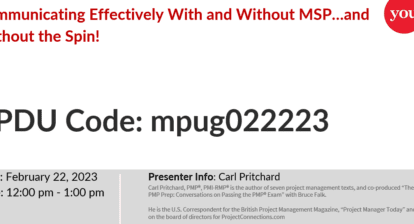
The success of any project is indisputably tied to the quality of the team members working on it. As a project manager, you play a key role in the recruitment, hiring, and management of talent. This includes establishing team culture, resolving conflicts, and rejuvenating your team when morale and energy wanes.
In order to do all of this successfully, it’s important to ensure you find and hire the right folks for the job. In the past, hiring managers tended to primarily consider professional skills and certifications when hiring. Though these are important, hiring people with strong soft skills (e.g., social skills, communication skills, personality, attitude, mindset), is key when it comes to creating an efficient project team. This ensures better teamwork and communication, and ultimately, has a positive effect on the outcome of the project.
Let’s explore some tips to help you select the right people for your project team and contribute to the success of your project.
Job Analysis and Job Descriptions
Attracting the right candidates requires a detailed job analysis and writing an accurate job description. Gather information about the responsibilities, duties, and work environment for the job. If you’re filling an existing position, determine what (if anything) you want a new candidate to do differently from the person in the existing role. Reference data from the analysis when you write the job description. The job description should include a company overview, responsibilities, skills required, work schedule, and salary (optional).
Plan a Recruiting Strategy
Once you’ve written a job description, it’s time to attract the talent you need. Searching for professional-level talent requires a strategy. This often starts by holding a meeting between you and the other (current) team members and any others in the organization involved in the hiring process. Each person at the table should discuss what they’d like to see in a new hire. Discuss timelines (for example, when do we need this person to start), and the ways in which others on the team will work with the new hire.
Once your recruiting strategy has been established, post the job opening on recruiting websites or work with a recruiter (headhunter) to find qualified applicants. Once you feel you’ve received enough applications, you can begin reviewing them and determine who you want to interview.
Prescreen Candidates
While someone may look good “on paper” and seem like a perfect fit for the job based on their resume, judging them by their CV isn’t enough. Speak to potential hires on the phone before a formal interview to help you learn about their qualifications and personality. This saves time, as you’ll reserve the in-person interviews for the people who may be the best fit, not only for the job but who can best integrate into and collaborate with the team. Doing initial phone calls is also a great way to assess a candidate’s salary requirements prior to inviting them for an interview, so you can rule out anyone whose salary expectations are beyond your budget.
Ask the Right Questions
Interviews are uncomfortable for many of us—even the hiring manager! Prepare ahead of time by determining what questions you will ask prior to the interview. Use a combination of open-ended questions and definitive questions. If you’re recruiting for a role that requires specific knowledge—for a position that requires a lot of technical know-how, for example—be sure to test your candidates on the required skills.
Look for Team Members Who Work Well with Others
Finding a skilled professional isn’t enough. Teamwork and collaboration are key to the productivity of a team and the success of a project. Sometimes, the right fit is better than finding the most experienced candidate. If you can, involve other team members in the interviewing process, particularly those who this person will be working with and/or reporting to directly. Involving your team members in the hiring process can help you pick the right person for the job because they will not only have the skills to execute what needs to be done but be able to communicate and work effectively and efficiently with others.
Candidate Scoring
After each interview, each person on the interview panel should write down their feedback about the candidate—and prior to talking to each other. This avoids bias and ‘groupthink’ and helps each person assess the candidates honestly. You can also implement a numeric ranking system based on the qualities you are looking for (e.g., 1-5 points per category/attribute). Scoring can allow you to reject or pursue candidates and prevents interviewers from staying neutral throughout the process.
Move Quickly on Making an Offer
The best applicants for the job typically have a number of options available to them, so even a small delay could result in losing them. Once you and the other interviewers have selected the best candidate(s), make the job offer as quickly as possible. Call the candidate you want to hire and share information about pay, benefits, and anything else not covered in the interview. You can follow up with an official letter once your offer has been made. Making the offer via phone call helps you avoid letting too much time pass between the interview and the offer.
An Efficient Team Starts with You
Once you’ve got the right people hired for the job, it’s time to put your nose to the grindstone and get the project rolling (or continuing, depending on where you are in the life of your project). Creating an efficient team starts with you. In order to get the most from your team, follow these best practices for managing your newly found talent:
- Be a decisive, inclusive leader: Make decisions based on the information you have, hand-in-hand with your team members. Giving team members the opportunity to be a part of the process will help them feel like equal partners on the project, and boost motivation to focus on their work as they are seen as valued contributing member.
- Regularly communicate with your team: Clear communication about goals, expectations, and responsibilities with each of your team members is essential. Let your team know you have an “open door” policy to keep the lines of communication open, so everyone can understand what is expected of them at all times. It also helps them feel appreciated when they know you can approach you if a problem arises.
- Spend time on team building: Team building activities such as collaborative games, team lunches, etc. can bring your team together to get to know one another, with the aim of helping the team work as a cohesive unit to complete the project. As a project manager, you can plan activities outside of regular work duties to help keep the enthusiasm, cohesiveness, and morale boosted throughout the project.
Conclusion
Choosing the right project team members can help make your project the success you want it to be. Building the right team can be challenging, and we don’t always get it right. If some time goes by and you realize you’ve hired the wrong person, don’t fret. Learning from failure can teach you important lessons. Project management requires custom solutions to bring success, so use your experience to find the right approach—and the right people—for the team you manage.






